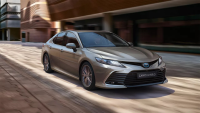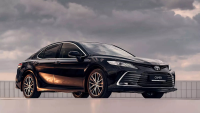Suppose you have enough money for a car such as a Toyota Camry or Nissan Teana. Which car of these two is your preference? What is better? Let's try to answer this question.
These sedans are some of the most popular cars on the Russian market among buyers. Camry and Teana are the brightest representatives of this body in the middle and business class. The owner of such a car gets quite high comfort for a reasonable price.
The first model is the undisputed sales leader in this segment for many years and is clearly not going to give up its position. It has gained millions of fans and has become the benchmark of an executive car in its price range. The second model has been catching up for a long time, yielding to our "champion", but last year it tried to come forward briskly and catch up with the leader, and perhaps even bypass him. Will the multiple winners manage to keep the title, or the competitor's ambition and strengths will prevail in this struggle? Let's compare these cars and find out the answer. In the "blue corner," the absolute champion and holder of the "best-selling sedan" title is the fifth-generation Toyota Camry, while in the "red corner," its bursting rival, the third-generation Nissan Teana, is the most recent model to date.
Interior, trunk and options
One of the most important indicators, which in the first place pay attention when buying a business class car is the interior, in particular - the space. Both models have always had plenty of room for passengers both in the front and rear. Although externally Nissan seems to be more voluminous car, inside the last version of Camry turned out to be more spacious than its rival. However, by and large, in both cars passengers of the second row will be comfortable.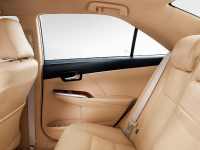 Speaking of Toyota's rear seats in the maximum configuration, it is worth noting that there is a small control panel on the back of the armrest, with which you can adjust the angle of the seat backs, the temperature of the climate control, the volume of the radio and flipping tracks in the playlist. This option does not only make the trip convenient for passengers of the second row, but also contributes to less distraction of the driver. The new Teana does not have such "pluses". The rear side of the competitor's armrest is limited only to cupholders and seat heating buttons.
Speaking of Toyota's rear seats in the maximum configuration, it is worth noting that there is a small control panel on the back of the armrest, with which you can adjust the angle of the seat backs, the temperature of the climate control, the volume of the radio and flipping tracks in the playlist. This option does not only make the trip convenient for passengers of the second row, but also contributes to less distraction of the driver. The new Teana does not have such "pluses". The rear side of the competitor's armrest is limited only to cupholders and seat heating buttons.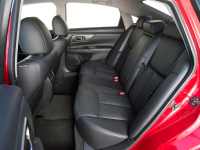 Having opened the trunk in both models, we understand that Nissan continues to be slightly inferior to Toyota. The useful volume of the trunk in the Teana is 474 liters, and in the Camry - 506 liters. It is noteworthy that the maximum modification of Toyota has a mechanism to adjust the tilt of the seats of the second row. Since it is located next to the trunk, its placement consumes part of the useful volume. But even in this case, the volume of the trunk of the Camry is 483 liters, which is still 11 liters more than that of the contender for the title of "champion" of the best-selling sedans.
Having opened the trunk in both models, we understand that Nissan continues to be slightly inferior to Toyota. The useful volume of the trunk in the Teana is 474 liters, and in the Camry - 506 liters. It is noteworthy that the maximum modification of Toyota has a mechanism to adjust the tilt of the seats of the second row. Since it is located next to the trunk, its placement consumes part of the useful volume. But even in this case, the volume of the trunk of the Camry is 483 liters, which is still 11 liters more than that of the contender for the title of "champion" of the best-selling sedans.
At first glance, it may seem that the Toyota Camry is the unqualified leader, but it is not. Although Toyota's interior is more solid and ergonomic, the car is not ready to offer buyers all the technical equipment of Nissan, even in the maximum configuration. The premium version of Nissan Teana is equipped with the system of tracking blind spots, recognition of moving objects from the back of the body, lane control and other options that greatly simplify the life of the driver. Unlike the leader, it has a ventilation system for the front seats.
One of the most convenient options available in Nissan, but not in Toyota, are the cameras located around the perimeter of the car. The Camry is equipped with only a rear camera, displaying an image on the dashboard screen, while the Nissan driver has the ability to get a 360-degree view. Each camera captures a separate picture, but on the Teana's monitor you see your car from above along with the objects moving around you. A big fat plus for the challenger. But it's not enough to win, of course.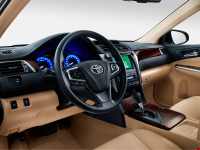
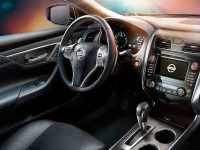
Engine and transmission
For 2016 Nissan Teana third generation prepared for the market two types of engines:
A 2.5-liter inline-four;
V6 of 3.5 liters.
In the Toyota Camry, things are more varied:
A 2.0-liter four-cylinder engine;
Four-cylinder 2.5-liter;
3.5-liter V6.
In terms of power, the Nissan loses in all categories. For the 2.5L engine, it produces 172 hp versus the Toyota's 181 hp, and the 3.5L engine makes 249 hp versus 268 hp.
The Teana has a variator as a gearbox, due to which switching is not felt. The car goes smoothly, without jerks. If you miss the drive which was generated with gear shifting and accompanying vibrations, switch the lever to Ds position. It will bring you back to the way you used to feel. The Camry also has a CVT, but the model mostly comes with a 4-speed and a 6-speed automatic. Compared to its opponent, the "champion" box behaves nervously: the engine runs at higher revs, shifts are delayed, and the ambiguous dynamics make you distracted. Yes, this car is faster, but when you press the gas pedal in Camry you lose the feeling of comfort and lightness that doesn't leave us in Teana at any speed.
Manageability
As to the manageability of "Japanese", it is difficult to give a clear verdict. Let's analyze in order. Camry evidently lacks recoil of a steering wheel. It is deprived of rigidity and hangs from side to side. It is a little bit disconcerting, because the driver loses the sense of control over the automobile. It turns out, that the strong feedback is obviously not Toyota's end. However, things are quite the opposite at Teana - a steering wheel is rigid and responsive, instantly reacts to movement of driver's hands and implements all its maneuvers. It equally concerns both small manipulations, and turns at a serious angle. Besides, Nissan has no problems with turning ability. Toyota clearly loses in this indicator. On high-speed turns one feels that after rotation of front wheels it should pass time that rear ones should join the maneuver. But after switching from the sport mode to driving in a smooth manner, everything falls into place: Camry moves smoothly, accurately and precisely.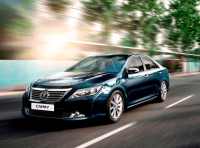 One of the main indicators of the suspension of business class cars is the sensitivity to bumps. In this respect, the Toyota unconditionally wins - bumps and changes in road relief are almost not noticeable. Given that the comparison of models is made within the framework of Russian roads, the state of which leaves much to be desired, in Toyota you will definitely feel more comfortable.
One of the main indicators of the suspension of business class cars is the sensitivity to bumps. In this respect, the Toyota unconditionally wins - bumps and changes in road relief are almost not noticeable. Given that the comparison of models is made within the framework of Russian roads, the state of which leaves much to be desired, in Toyota you will definitely feel more comfortable.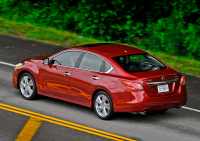
Sorenesses
A new car is almost always flawless. However, for completeness of the picture when comparing it is necessary to pay attention to weaknesses and sorenesses of both opponents. Especially since the release of the latest versions has passed enough time, and drivers have a certain opinion about the cars.
Weaknesses of the Toyota Camry
In comparison with the v40 modification, the interior of the fifth-generation Camry model looks more solid. There are no "pseudo-wooden" elements, and the interior is made richer. However, the quality of the stuffing leaves much to be desired. After some time after purchase the seats are sagging and the leather is stretched. The armrest is not rigid enough, so under regular pressure it can also lose its shape. Of course, in the presence of these defects in the service you will replace the filler under warranty, but the very fact of the presence of this moment on a business class car is alarming.
Another major flaw is the paint coating. The manufacturers of Toyota have obviously spared on it. On average the thickness of the paintwork is 100-120 microns, which is quite low. The car begins to rot from the inside - rust appears on the inside of the hood and trunk. There is traditionally only a primer about 50 microns thick. So, if you buy a used car, look under the cover.
There are no expressed claims concerning an engine, gearbox and running gear. Everything is within the declared run. However, it is necessary to be attentive to purchase Toyota with 1,8 L engine. The car weighing 1.5 tons will not be easy to pull. The most popular types of powertrains are 2 and 2.5-liter motors.
Weaknesses of the Nissan Teana
As for the new Teana, it has also become noticeably better than the second-generation model (J32). The previous models were scolded, above all, for drivability. In the L33 body, the car became much more pleasant to drive. At the same time, the comfort, for which the ancestor was so appreciated, remained at the same high level. But together with the advantages the new model has inherited also weak points. The variator has remained the problem area in the automobile. It is extremely important to change oil in a box in time and to avoid loads - it is prohibited to slip on CVT. Adhering to these recommendations can extend the life of the transmission.
The opponents have common weak points - it is paint coating. For Nissan the paint also begins to chipping at the slightest impact, and the place of chipping quickly forms corrosion. The optimal way out of the situation will be repainting. And it is better to do it at your own expense, because the lacquer applied under warranty, is not of great quality.
On this parameter both models have flaws, but not critical. Therefore, in this round it is a draw!
To sum it up.
Both "Japanese" are good in their own way. Each has its own advantages and customers. Toyota Camry is slightly roomier and more elegant, but Nissan Teana is more technological. Camry highlights the status of the owner, but Teana is more modern and more clearly meets the challenges of the time. The first has a powerful engine and perfect "swallowing" of irregularities on the road, and the second - smoother shifting of gears and better steering response. One is safer and the other is cheaper. Who won? Probably, the winner is different for each car owner.
Objectively looking at the figures of sales, it becomes clear that no one dumped the Camry from the pedestal. And how things will be in the future, it is difficult to say. Toyota knows "the secret of success" and gives customers what they want - comfort, safety and status. Besides Toyota as a brand is more loved all the same. Will Nissan be able to "belt out" its competitor in a few years? We shall see. And now we are dealing with undefeated king - Toyota Camry.
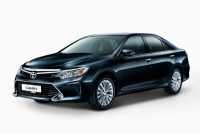
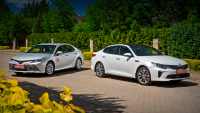
-rear-and-front-view-camera-6.png)
